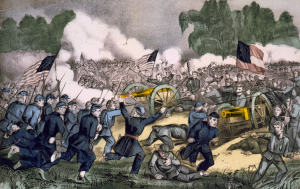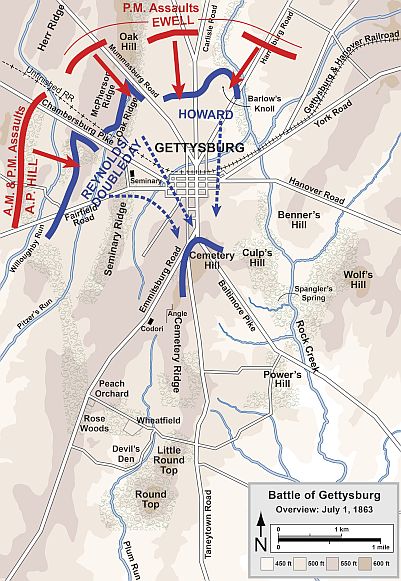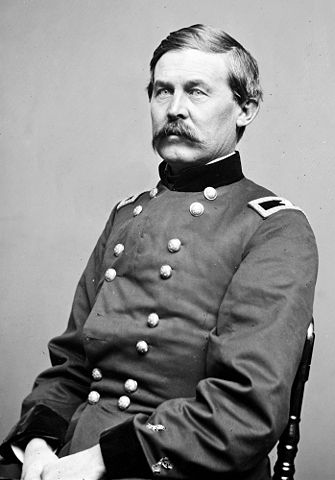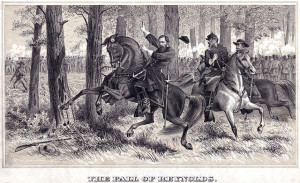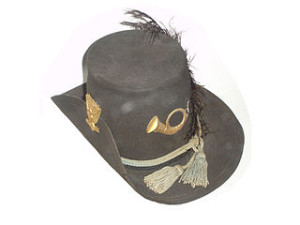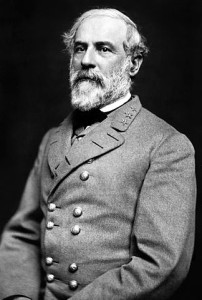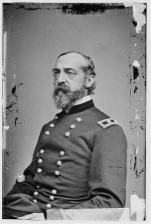Spencer Carbines Helped John Buford’s Unmounted Cavalry Hold The High Ground
…Or Did Buford’s Cavalry Use A Different Carbine?
Gettysburg, July 1, 1863.
As General John Buford’s unmounted cavalry held the high ground for the Union on July 1, 1863, on the outskirts of Gettysburg, they had a technological advantage over the Confederates they were fighting.
There has been confusion and debate about whether or not John Buford’s unmounted cavalry had Spencer carbines on the morning of July 1, 1863, at Gettysburg. Were they using breech-loading Spencer carbine rifles or other weapons? No matter which particular weapon they used, their weapons allowed the Union men to fire at a rate comparable to a larger unit of men. Buford’s strategic deployment and positioning of his unmounted cavalry that early July 1, morning at Gettysburg also contributed greatly to the Union holding the high ground.
Here, I will give a few arguments both pro and con about Buford’s men having Spencer carbines the first day of Gettysburg.
It may be worth noting the Definition of CARBINE:
1: a short-barreled lightweight firearm originally used by cavalry
2: a light short-barreled repeating rifle that is used as a supplementary military arm or for hunting in dense brush
Source: Merriam-Webster online dictionary. http://www.merriam-webster.com/dictionary/carbine
Did General John Buford’s Cavalry Have Spencer Carbine Rifles?
Readers of this blog will notice this post has generated some comments with discussion and controversy, regarding whether or not John Buford’s cavalry had Spencer carbines on the first day of the Battle of Gettysburg, or if they had another type of carbine.
Below, we have two opposing views on this matter and a post update with more explanation.
For the sake of argument, I’ll provide the view supporting Buford having Spencer carbines at Gettysburg, and Professor John Vogt of Newman University in Wichita, Kansas, provides us the viewpoint that Buford did not have Spencer carbines at Gettysburg.
I think both points of view are worthy of consideration as both are backed up by credible sources. Sometimes history is messy.
In the end, I’ll leave it up to the reader to decide for him or herself regarding John Buford’s use or non-use of Spencer carbines/rifles on the first day of the Battle of Gettysburg. If anyone has information to add, then please contribute!
I thank Professor Vogt for his contribution to www.learncivilwarhistory.com.
BUFORD’S CAVALRY COULD NOT HAVE HAD SPENCER CARBINES AT GETTYSBURG
The history of the Spencer company is chronicled in the book, ‘Spencer Repeating Firearms’ by Roy Marcot (Irvine, CA: Northwood Heritage Press, 1983). This well-regarded but out-of-print work appears on the Smithsonian list of Selected Bibliography on Firearms (http://www.si.edu/Encyclopedia_SI/nmah/firearms.htm) and is an indispensable resource for anyone interested in Spencer firearms. Tony Beck has relied on it heavily for his article ‘Spencer Carbines’ (http://www.civilwarguns.com/spencer1.html).
Marcot’s impeccable research leaves little room for doubt. The first Spencer carbines were delivered in early October 1863 (Marcot, pgs 66-67.) Whatever repeaters Buford’s men might have had that first day of July in 1863, they were not Spencer carbines!
Prof. John Vogt
Newman University
Wichita, KS
Post Update
On July 1-3, 2017 the Civil War Trust held a number of Live Events on its Facebook page. During the live feeds, Civil War Trust historians gave talks as they walked noted areas of the Gettysburg battlefield. Those who were watching the live Facebook feeds were invited to ask questions. I took the opportunity to ask if John Buford’s cavalry had Spencer carbines the early morning of July 1, 1863, at Gettysburg.
Here are the replies of noted Civil War and Gettysburg historians Garry Adelman and Wayne Motts:
Garry Adelman: “Somebody asked. I think it was Jonathan, whether Buford’s men had Spencer carbines. […] People say that all of Buford’s men Spencers, [that] all of Buford’s men had Henry Repeating rifles, and things like that. Wayne set us straight.”
Wayne Motts: “Well, the record shows, from ordnance records we have here, that most of Buford’s command had the standard weapon the cavalry be issued in the Civil War. That’s going to be Burnside, that’s going to be Sharps carbines. Sharps carbines is going to be the principal weapon that Buford is going to have here on July 1st, 1863. So, they did not have repeating weapons although that’s a myth that almost won’t die that Garry and I deal with on a daily basis.”
Here is a link to the Civil War Trust’s Facebook page:
Civil War Trust Facebook Page
Look for the replay of the Facebook Live Event which was live on July 1, 2017, at 9:30 a.m. titled:
Civil War Trust Facebook Live: The First Day’s Outer Line-McPherson’s Ridge to Barlow’s Knoll with Garry Adelman, Wayne Motts, and Kristopher White.
My question is answered at approximately the -17:00 mark of the replay.
What The Civil War Trust Does In The Trust’s Own Words
“The Civil War Trust is the largest and most effective nonprofit organization devoted to the preservation of America’s hallowed battlegrounds. Although primarily focused on the protection of Civil War battlefields, the Trust also seeks to save the battlefields connected to the Revolutionary War and War of 1812. Through educational programs and heritage tourism initiatives, the Trust seeks to inform the public about the vital role these battlefields played in determining the course of our nation’s history.”
Here is a link to the Civil War Trust’s website:
Civil War Trust
Garry Adelman is Director of History and Education for the Civil War Trust.
Wayne Motts is the CEO of The National Civil War Museum in Harrisburg, Pennsylvania. He is also a Licensed Battlefield Guide at Gettysburg National Military Park.
JOHN BUFORD HAD SPENCER CARBINES AT GETTYSBURG
In addition to sources I have provided further below in my reply comment to Mr. Ken James, I’ll quote some passages from the book They Met at Gettysburg by General Edward J. Stackpole (Harrisburg, Pennsylvania: Stackpole Books, 1956).
From pages 55-56, Stackpole is writing about the Affair at Hanover which occurred on June 30, 1863. Near Hanover, there was a skirmish between Stuart’s cavalry and a squadron of Yankee cavalry that was part of Judson Kilpatrick’s cavalry division.
The first passage I’ll use from my source is to support and setup the second passages I’ll use. Here we see, according to Stackpole, that Spencers were in use by Federal cavalry in June, 1863 during the Gettysburg campaign:
“Stuart’s weary troopers were in no condition to contest the right of way with the Federal cavalry, whose new lease on life and improved morale had recently been given a special fillup with the issue of the new Spencer rifle, a seven-shot repeating arm that was the equivalent of at least quadrupled manpower for dismounted fighting.
“The 6th Michigan and 1st West Virginia Cavalry regiments, of Custer’s and Farnsworth’s brigades respectively, are known to have been recently armed with the Spencer repeater, and both were engaged with Stuart’s troopers in the Hanover skirmish. Whether they used their Spencers effectively from horseback is questionable, but the fact remains that Kilpatrick definitely blocked Stuart from the two roads leading north from Hanover to Carlisle.”
Now, quoted below are various passages from pages 120-122 of the section Buford’s New Tactics from Stackpole’s book that I believe support the argument of Buford having Spencers at Gettysburg. I’ll include some passages that talk about Buford’s style, and background of fighting with cavalry, which I think are interesting and pertinent to how Buford and his cavalry fought at Gettysburg:
“For his part Buford considered the saber to be of little practical value. He thought of the horse as a means of transportation, useful chiefly because of the greatly increased mobility which it gave to the mounted troops. He treated the cavalry as mounted infantry, and instilled that belief in his brigade and later his division, until it became practically instinctive. The procedure was to move rapidly to a critical position and dismount the troops to quickly form an infantry skirmish line while one out of every four men became horseholder for the group, under cover to the immediate rear, ready at all times for the set of fours to remount in an instant and gallop off to a new position.[…]
“[…] The extent to which the Spencer seven-shot repeating rifle contributed to Buford’s success in Virginia is not entirely clear, but careful researching in the last few years has uncovered material which may cause historians to reappraise the relative cavalry capabilities of the opposing sides and the resulting impact on Civil War campaigns and battles following Chancellorsville.** What is certain is that Buford’s cavalry division was armed in part with the repeater before leaving Virginia for the Gettysburg campaign and concurrently several regiments of Kilpatrick’s division received an issue of the same new weapon prior to their fight with Stuart at Hanover on June 30. It is therefore not difficult to imagine the superior firepower that the Federal cavalry was enabled to bring to bear against the Confederates who in the main were still forced to rely on their muzzle-loading single shot muskets both at Hanover and at Gettysburg on the morning of the first day.”
**J. O. Buckeridge, Lincoln’s Choice, The Stackpole Company, Harrisburg, 1956.
The Firepower Of The Spencer
Following are videos demonstrating the difference between loading and firing a Civil War musket, and a Spencer carbine. The musket must be reloaded after each firing, while the Spencer could fire seven times before a reload. In the heat of a battle, which one would you prefer to have?
Civil War Musket Shooting Demo
This is a demonstration of the steps, and time, required to load and fire a musket. A Civil War soldier would be loading and firing faster than in this demonstration.
Shooting An Antique Spencer Carbine
In the below video, the gentleman fires the Spencer three times. I don’t think he is particularly skilled or fast with his firing, but we’ll cut him some slack because the video’s explanation text indicates: “Shooting a Model 1865 Spencer Carbine. First trial after converting it to centre-fire so it can use available ammunition.” So, he may only be doing some test firing after converting the rifle to centre-fire. You will notice that between the first and second shots he fumbles somewhat with the cocking. A Civil War soldier would not want to do that, that small fumble may cost him his life.
Shooting The 1865 Spencer Rifle
A dramatic demonstration of a Spencer carbine at work. In this video, you’ll see how a Spencer was loaded using a tube magazine that could hold seven rounds. All seven rounds could be fired in under a minute. Confederates called the Spencers; “the damnyankee rifles you could load on Sunday and fire all week.”
Further Reading
If you perform a Google search for “john buford spencer carbines” there will be about 2,280,000 results. Some of the search result web pages will provide information that supports John Buford having Spencer carbines on July 1, 1863, at the Battle of Gettysburg, and some web page search results will say the contrary. Here are only a few of the search results:
Information Supporting That John Buford Had Spencer Carbines
Google Books: American Civil War: The Definitive Encyclopedia and Document Collection
Information Not Supporting That John Buford Had Spencer Carbines
Weapons at Gettysburg – The Spencer Repeating Rifle
Book review: “The Devil’s to Pay”: John Buford at Gettysburg. A History and Walking Tour
